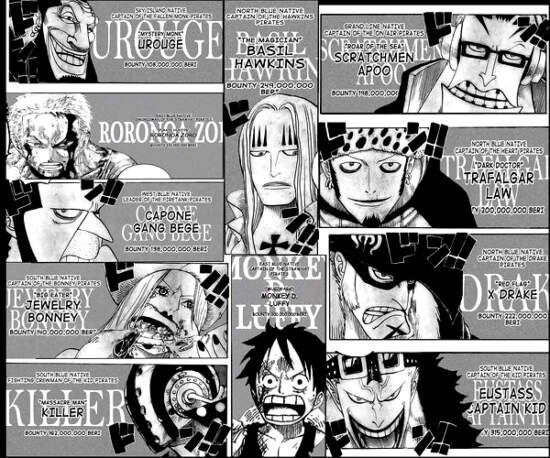One Piece
Shueisha (JP)/Madman Entertainment (AU), July 19, 1997-present
Writer: Eiichiro Oda
During the early 2000s, three manga titles were universally regarded as “The Big Three”. These were Eiichiro Oda’s “One Piece” (1997-present), Masashi Kishimoto’s “Naruto” (1999-2014), and Tite Kubo’s “Bleach” (2001-present). The three titles make up a triumvirate of iconic teen action themes – “One Piece” features pirates, “Naruto” features ninjas, and “Bleach” features samurais.
Actual sales rankings paint a different picture from fan perceptions of success. Measured by revenue, “Naruto” and “Bleach” regularly rise, fall, and trade places with other manga titles. “One Piece”, on the other hand, consistently takes the top spot. The title breaks sales and publishing records on a regular basis. Volume 57, in particular, has a print run of three million copies in 2010, making it the highest first print not just for a manga, but for any Japanese book as at time of print.
As at 2015, “One Piece” continued to dominate in terms of manga sales. “Naruto” has ended its run. “Bleach” is struggling to remain in the top five.
What, then, is “One Piece” about and why is it so consistently popular?
“One Piece” is a fun manga about super-powered pirates. The story starts with the surrender of the so-called Pirate King, a character called Gol D. Roger, who has attained all the wealth, power, and fame that anyone would ever want. Roger surrendered for reasons undisclosed in the story at the time. World Government authorities decide to publicly execute the pirate, in order to discourage other people from becoming pirates.

The execution had the opposite effect, as Gol D. Roger used his execution as a platform to rally people to the pirate way of life. Roger declares to those in attendance at his execution that all of his fortune is ready for the taking if one can find it in “that place.” Various translations offer different takes on Roger’s last words. The manga has not made it clear whether Roger is talking literally or figuratively. But the words were a catalyst for the plot: they inspired a new generation of pirates who dream of becoming the next Pirate King. (The historical inspiration for Gol D. Roger was a French pirate named Olivier Levasseur, nicknamed “La Buse”, or “the Buzzard”, who is known for being in possession of a big treasure cache. During his public execution Levasseur dared people to find his treasure.)

This new generation of pirates include the protagonist, Monkey D. Luffy, and other contemporaries who go on to become the World Government’s biggest headaches. The story then works as an adventure that follows Monkey D. Luffy and his pirate crew as they try to find the treasure while also attracting equal numbers of friends and enemies.
Serving as the framework to this adventure are various factions with opposing goals. The bureaucratic World Government, the mysterious Revolutionaries, the powerful Four Emperors of the Sea, and all the upstart pirate crews that terrorize the seas: all stuck in a very colorful, world-spanning Mexican standoff.
As stated above, the pirates possess various inhuman powers. The device for this are “devil fruits”, which grant unique abilities in exchange for being forever rejected by the sea. This includes contact sea water in any form, such as solidified states of seawater called “seastones”. An individual vested with abilities by devil fruits becomes too weak to move upon physical contact with seawater. This is a plot twist intended to debilitate characters, given that crossing vast expanses of the ocean is a crucial part of the story. These acquired abilities add flavor to the story, without the story being reliant upon this fantastic suspension of belief.
“One Piece” is indistinguishable from other shonen franchises in some respects: it uses formulae common among the young boy-focused genre – naïve and morally upstanding male protagonists, overwhelming themes of camaraderie, self-sacrifice, problems that are resolved through sheer strength of will, and lots of flashy combat.
But the truth is that writer Eiichiro Oda excels at something that is very rarely done well, at least as well as “One Piece”, in the shonen genre: world building. Mr Oda has created a large world that feels bigger than his characters. It is full of detail, texture, and people that live their own lives separately from the main characters. The world in “One Piece” does not revolve around the protagonists and their importance – and sense of importance – in the story.
Readers will also rarely, if ever, get the impression that the author is making things up as he goes along. Mr Oda peppers the series with details, background stories, even mythologies that serve as framework for future developments in the series. Legends or rumors told offhand in early chapters eventually turn into important plot springboards years later, but never detracting from the main story. Seeding a plot takes forward planning, and works extremely well in very long periodical storylines. Mr Oda does this exceptionally well.
Most of the manga franchises that have run for as long as “One Piece” did are said to have only been possible because the author does not know how to end things, or because the publishers are forcing the author to keep a lucrative franchise alive (something that no manga author will admit out of a sense of professional pride). Neither seem applicable to “One Piece”. With over eight hundred chapters, and almost 2 decades in, “One Piece” reads like a single, cohesive story written with a predetermined beginning and end.

